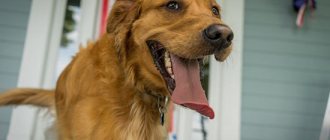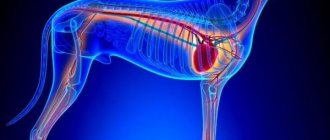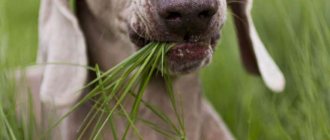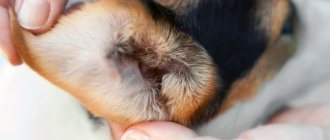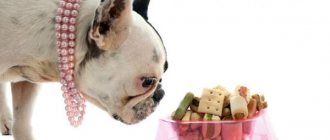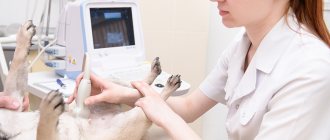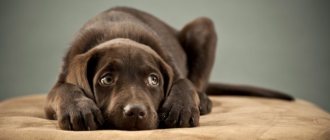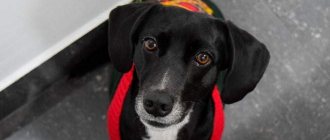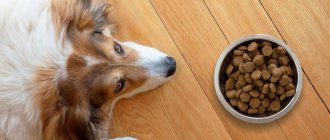Every pet owner needs to know why their dog is losing hair and going bald in places. Owners of animals of different breeds and ages may encounter a similar problem. To eliminate it, they need to immediately contact a veterinarian, provide the pet with full medication treatment and good care.
It must be taken into account that baldness in pets often indicates significant health problems. It may indicate the presence of parasites, changes in hormonal levels, and dermatological diseases. It is important for the owner of the animal to establish the exact cause of this condition of the animal, otherwise he will not be able to cope with hair loss even if he carefully follows the veterinarian’s recommendations.
What is alopecia?
This is hair loss in animals. It may be associated with the natural change of hair coat - molting, but often takes on pathological forms in which the animal experiences baldness of certain parts of the body, the appearance of ulcers and inflammations, as well as tissue pigmentation. Such individuals often have a “fur coat” that comes out in tatters. Such a symptom almost always indicates serious malfunctions in the body’s functioning - hormonal changes, disruption of the functioning of internal organs, or infection of the pet with parasites.
When such a problem arises, the dog owner needs to remain calm. If he notices moderate hair loss in the spring or fall, there is no need to worry. However, if this process begins in winter and is accompanied by a general deterioration in the dog’s condition, the appearance of islands of bare skin on the paws, face, and stomach, you should consult a veterinarian. In most cases, a specialist is able to cope with such a scourge quickly without consequences for the animal’s health.
Main symptoms
An attentive owner will immediately notice that the dog is behaving inappropriately:
- The animal is restless, cannot sleep peacefully, often jumps off, itches, and may whine and howl.
- Scratch marks appear on the skin, and the vegetation thins out.
- In those places that are devoid of hair, inflamed, swollen areas appear, which can look like inflamed wounds or even like purulent wounds.
- If the affected area is around the eyes, they may become inflamed, swollen, and mucous or purulent discharge may appear.
- The most commonly affected areas of the body are the muzzle, armpits, inguinal folds, genital area, undertail and abdomen.
- The dog may lose his appetite and not even respond to his favorite dish or tasty brain bone.
- When trying to examine a sore spot, the dog becomes aggressive and can even bite a person, including its own owner.
- If the skin is severely damaged, the animal's temperature rises, it becomes lethargic, apathetic, lies indifferently, or even tries to hide in a corner.
Before taking measures, you must undergo an examination in a clinic, since skin diseases are not always the cause of baldness. Such problems need to be treated “from the inside”, and only a doctor can identify them.
Why might a dog lose hair?
This phenomenon may occur for the following reasons:
- Due to hormonal imbalances. These include hypothyroidism (with this disease there is dysfunction of the thyroid gland, the skin turns black), hyperestrogenism, Cushing's syndrome, hypoestragonism. Also, a similar phenomenon can be observed in bitches during pregnancy and after childbirth. It does not apply to a number of pathologies.
- Because of stress. They may be associated with a change of place of residence, the death of the previous owner of the animal, or the appearance of other animals in the house. In this case, the pet often loses its hair in clumps to bald spots, there is increased excitability, urinary incontinence, and frequent howling. In this situation, the animal must be given sedatives to relieve symptoms.
- Exposure to allergens on the body. These can be ordinary dust, synthetic materials, and some products included in the animal’s diet. Severe itching, dandruff and hair loss can be caused by the use of low-quality hygiene products: bad shampoos, pet care balms, plastic combs, synthetic leashes, collars, clothing.
- Due to severe infection of the body with parasites: ticks, helminths, fleas. In such cases, the owner will observe not only hair loss, but also severe wounds on the pet’s back, as well as on the pet’s neck, around the tail, and lower abdomen. The animal will constantly scratch these areas due to severe itching. The problem can only be eliminated through antiparasitic treatment of the animal.
- With vitamin deficiency. Accompanied by the appearance of bald spots on the ears, as well as on the face and back of the dog. The condition of the animal with such a disease worsens: there is a decrease in appetite, an exacerbation of chronic diseases (if they have occurred). This problem occurs more often in the off-season, which is why it is often confused with regular molting.
- Due to bacterial infections. In such cases, the dog’s hair falls out profusely and it itches. At the same time, the pet becomes bald in places, the thickness of the hair on healthy areas of the skin does not change.
- For fungal infections of tissues. The most common ringworm in dogs is trichophytosis. Puppies under the age of one year are highly susceptible to such diseases. The diseases are accompanied by the formation of ulcers on the skin, thinning hair, and the appearance of dandruff. Such pathologies are very contagious and are easily transmitted from one animal to another through direct contact, bedding, and toys.
- With acanthosis nigricans. This is a lesion of the sebaceous glands, in which pigmentation of the skin is observed in the groin area, as well as under the armpits. Accompanied by severe itching and the appearance of hard scales on the tissues.
- Due to idiopathic alopecia. This is a specific disease to which representatives of the Greyhound breed are prone. Accompanied by hair loss on the abdomen and thighs. The skin with this pathology remains healthy and does not require specific treatment.
- For adenitis of the sebaceous glands. The disease primarily affects puppies. With this pathology, the owner notices that the animal’s hair is falling out, and in this place there is red skin covered with peels or a greasy coating. The disease requires the use of corticosteroid therapy.
- Due to injuries. These include severe bites, burns, and cuts.
Also, hair loss may not be associated with pathological processes in the body. Twice a year, the hair on the dog’s body is renewed naturally and there are periods of shedding. If your pet's general health does not deteriorate during this time, there is no need to worry about this. Wait for this phase to end naturally and continue caring for your pet.
How to determine the cause of baldness?
If your pet's hair loss is associated with regular shedding, there is no need to worry about it. It is enough to continue to care for his coat, and this process will end naturally. If your animal has severe alopecia, you should consult a veterinarian. He will conduct the following studies to determine the cause of this condition:
- A general examination of the pet, a survey of the dog’s owner, allowing you to determine in what conditions the dog lives, how long ago his hair loss began, and what processes it is associated with. The doctor will definitely clarify whether there have been contacts with wild animals, changes in hormonal levels, and whether the dog has chronic diseases.
- Blood and urine tests.
- Fur scrapings.
- If damage to internal organs is suspected, the animal may be prescribed an ultrasound or x-ray.
Based on the results of such an examination, the doctor will be able to determine the reason why the dog has a lot of hair and will select the appropriate therapy for it. This will allow you to quickly cope with the presented disease.
Solving the problem of out-of-season shedding
Having found out the reasons for the unusual condition of your pet, do not forget about regular combing of the fur; you should resort to this procedure both in summer and winter. Brushes made of natural bristles - pork or horse bristles - are best suited for this purpose. A pet with a long and thick coat should be combed once a week, carefully unraveling tangles and removing dead hairs. Smooth-haired animals need grooming a little less often; a medium-hard brush is suitable for them.
Decorative breeds of dogs, for example, Yorkshire terriers, need periodic haircuts with special scissors. Experienced breeders use special clippers for this purpose, which allow you to create a short, hygienic hairstyle in the summer and maintain the beauty of the coat all year round.
Changing food is also a solution to the problem faced by owners of furry pets. A dog sheds all year round if it does not receive all the necessary substances to maintain health. What to do in this case? Properly selected dry food contains essential vitamins and fatty acids, as well as valuable microelements. Often, correcting the diet allows you to get rid of troubles, especially if your pet has recently lost weight.
Hygiene plays a significant role in maintaining the beauty and health of a dog’s coat. It is not enough to simply clean the fur from dirt and dust in bad weather; the pet needs a bath.
What should the owner do? An animal that is constantly outdoors in the private sector in the summer is rarely washed. However, dogs that spend maximum time in the fresh air are practically not susceptible to slow hair loss, the reasons for this lie in regular physical activity and adaptation to environmental conditions.
A domestic dog sheds in summer and winter, and its owner is trying to figure out why this happens. Whatever the reasons for hair loss, the dog must be accustomed to water procedures from an early age.
To keep your pet healthy all year round, it is washed with a special shampoo that repels fleas and ticks. It is especially important to take care of your dog’s safety in spring and summer, when the risk of parasites increases.
But it is not recommended to bathe small lap dogs often, since their skin is prone to drying out, sometimes the dog resists water treatments and bites, why does the pet behave this way? The appearance of peeling and irritation leads to the fact that the ornamental animal begins to itch, thereby provoking hair loss. Such shedding can last a long time and harm the dog’s health.
First of all, you should consult a veterinarian to eliminate bald spots and redness, and also introduce healthy supplements into the diet that will improve the quality of the skin and coat.
Methods for treating hair loss in dogs
The strategy for combating alopecia is selected depending on the factor that provoked this phenomenon:
- If infected with ticks or worms, antiparasitic treatment will be prescribed. In the most severe cases, treatment for alopecia in dogs will involve antibiotics.
- If there is a lack of vitamins and macroelements in the body, the animal will be prescribed specialized complexes and feeds that have a high content of nutrients.
- If baldness occurs due to an allergy, the animal will be prescribed antihistamines, the owner will be advised to change the diet, as well as replace the dog’s accessories and hair care products (often these are the ones that provoke hair loss).
- In case of hormonal imbalances or severe general diseases, the dog will be prescribed long-term combined treatment aimed at eliminating the cause of alopecia. It may take several months.
To eliminate itching, skin inflammation, and dandruff, the dog will be prescribed special local medications that will need to be applied daily to the affected areas of the skin. Products containing melatonin help well in such cases. They are used until symptoms disappear completely.
If you follow all the veterinarian's recommendations, you can cope with alopecia in a few weeks. In the future, you will need to follow preventive recommendations so that the problem does not arise again.
Pet grooming
To quickly cope with this disease, it is extremely important to provide the dog with proper and complete care at home. It provides:
- Complete feeding of your pet. During the treatment period, it is recommended to give the dog food with a high content of vitamins, and to completely exclude from the menu all foods that can provoke allergies.
- Providing your pet with adequate rest and protection from stress. In case of infectious diseases, it is recommended to refrain from walking in public places and avoid contact with other animals, especially wild ones. If the dog lives in an enclosure, in a kennel, it is recommended to take him into the house and keep him there until he fully recovers.
- Use of a special protective collar. This remedy is used for severe itching to prevent the animal from scratching the skin. Effective if bald spots appear under the collar, on the face, around the eyes or ears.
- Regular brushing of your pet. Remember that fallen fur greatly irritates the skin and provokes intense shedding.
- The use of local drugs to relieve symptoms of pathology. If your doctor has not prescribed you an ointment, you can use olive oil for this purpose.
- Using special shampoos for bathing dogs. They must be selected by a veterinarian.
It is also extremely important to exclude the possibility of re-infection of the dog with parasites, pathogenic bacteria or fungi. To do this, you should treat the animal’s bedding (or replace it with a new one), its toys, bowls, and combs. The same should be done with the personal belongings of other animals living in the house.
Pregnant and lactating bitches suffering from hair loss should be provided with an enhanced diet. General medications are not used for such individuals, as they can negatively affect the development of the offspring. Sick puppies that have inflammation of the glands should be isolated from the rest of the litter. Otherwise, other babies can quickly catch an infection from them.
This type of care is provided until the dog fully recovers. After the symptoms of the disease disappear, he is again shown to the veterinarian. If he is satisfied with the condition of the animal, you can return to the normal rhythm of the animal’s life, remove restrictions on walking and choose a simpler diet for him.
Video: why does a dog lose hair, and what to do about it?
Prevention of alopecia in dogs
To avoid the occurrence of this disease, it is enough to follow simple general recommendations. They provide:
- Regularly examine your pet's skin. It is advisable to carry it out after clipping or washing your pet. When the first signs of afforestation appear, you should immediately consult a doctor.
- Follow the recommendations for caring for the animal's fur. It must be combed out during the molting period, otherwise it will cause skin inflammation and severe itching, which can cause alopecia.
- Providing the dog with a nutritious diet. Your pet's food should contain a large amount of vitamins and minerals. It is especially important to adhere to this rule during the molting period. If you do not know how to feed your dog to prevent hair from coming out, consult your veterinarian on this issue.
- Timely vaccination of the animal and regular deworming.
- Correct selection of accessories for your pet: collar, leash. You need to purchase only high-quality products that do not put pressure on the dog’s neck and do not rub.
The owner also needs to ensure that the pet does not come into contact with other animals or conflict with them, as it can become infected with dermatological diseases from them. If you follow these simple recommendations, you will not encounter alopecia in dogs.
Home Remedies
Are you feeding your dog cheap food from the supermarket? If your answer is yes, change your habits. Ask your veterinarian what the ideal diet for your friend is based on weight, age and energy expenditure.
You will have to create a food calendar that combines quality feeds with rich and moist recipes and other meals prepared by you. Dogs love routine, but it needs to be fun and stimulating, especially when we're talking about dogs like the Belgian Shepherd who have a pure wit and need constant motivation, as well as what they eat.
© shutterstock
